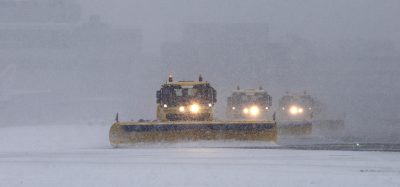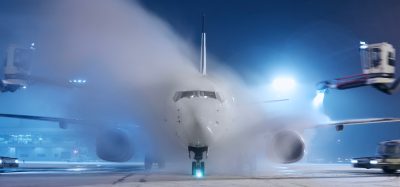Overcoming the winter challenge
- Like
- Digg
- Del
- Tumblr
- VKontakte
- Buffer
- Love This
- Odnoklassniki
- Meneame
- Blogger
- Amazon
- Yahoo Mail
- Gmail
- AOL
- Newsvine
- HackerNews
- Evernote
- MySpace
- Mail.ru
- Viadeo
- Line
- Comments
- Yummly
- SMS
- Viber
- Telegram
- Subscribe
- Skype
- Facebook Messenger
- Kakao
- LiveJournal
- Yammer
- Edgar
- Fintel
- Mix
- Instapaper
- Copy Link
Posted: 8 August 2011 | Zoltan Ormandi, Head of Airside Management at Budapest Airport | No comments yet
It was one particular snowy day at the airport last year when I signed off the use of a large amount of anti-skid material, perhaps more than I was used to seeing recorded in our operation logs. However, the request was essential given the winter conditions that we had to operate in. The minimum temperatures were exceptionally low at the airport during the last winter season. Compressed snow and icy banks built up on the airside aprons meaning that it was essential for the airport to take action.
The previous two winters were particularly challenging for the airport. The last six years preceding this threw up very little in the way of snow clearing difficulties, in fact, to quote one of my Duty Airside Managers; “One of the worst winters took place on a very nice Saturday afternoon!”
It was one particular snowy day at the airport last year when I signed off the use of a large amount of anti-skid material, perhaps more than I was used to seeing recorded in our operation logs. However, the request was essential given the winter conditions that we had to operate in. The minimum temperatures were exceptionally low at the airport during the last winter season. Compressed snow and icy banks built up on the airside aprons meaning that it was essential for the airport to take action.
The previous two winters were particularly challenging for the airport. The last six years preceding this threw up very little in the way of snow clearing difficulties, in fact, to quote one of my Duty Airside Managers; “One of the worst winters took place on a very nice Saturday afternoon!”
The 2009/10 and 2010/11 seasons were periods when the weather bared its teeth again. During these last two seasons our experienced snow removal staff had to be at the top of their games to deal with the conditions. This winter season started early at the beginning of November with heavy snow and temperatures between -3°C and -5°C. Having learnt from the previous year’s conditions the winter operations staff were on standby from the beginning of November so they could face the rigours of the conditions and keep the air traffic moving.
There are nearly 40 heavy duty snow removal machines on continuous standby at Budapest Airport, including runway cleaning and snow blast machines. On the aprons there are sweepers and snow transporting vehicles. The road network is treated by the small but very efficient Unimog road clearing machines. The fleet also includes two NIDO type spreaders for anti-skid operations and two Saab ASFT breaking action and friction tester cars.
Heavy snowfall
As mentioned, our approach to last year’s winter operations was based on the experiences of the previous winter season. Budapest Airport lies in the Carpathian Basin of Hungary where the surrounding mountains make the weather fronts particularly unstable. Because of this our weather predicting colleagues have a particularly difficult job to make reliable forecasts. Consequently we aim to keep the crew and machines on constant stand-by so that operations can begin swiftly and productively when the conditions take an unexpected wintery turn.
It was not until the beginning of December last year that we experienced any particular challenges. Up until then the runway surface braking action was always at a medium or high level on both runways and taxiways. Historical data showed that heavy snowfall is typical at the airport between temperatures of 0°C and -5°C. At night the temperature rarely went below -10°C. Between these temperatures the snow clearing machines and the anti-skid material Urea worked efficiently, both clearing and dispersing ice to an optimum result. To supplement the efficiency of Urea, particularly on extremely cold nights, we combined small amounts of Clearway de-icing liquid to the Urea formula.
Unusual conditions
This year however, we found ourselves facing some unusual and difficult conditions in very low temperatures. Even at the lowest temperature (-6°C to -11°C) it was still snowing heavily, while the night minimum temperatures were frequently between -15°C and -18°C.
During these conditions the Duty Airside Manager responsible for overseeing the snow removal process, had to make quick and decisive decisions on what techniques and methods needed to be used. It is during these abnormal temperatures that the Urea’s effect becomes rather limited resulting in the use of the Clearway formula on runways and taxiways. Last winter the quantity of Clearway liquid used matched the amount that we normally use within a three to five year period. It was certainly a challenge and something of an achievement that the logistics team of the airport managed to buy in the right amount of this liquid, particularly due to the huge demand across Europe.
It was the aprons that certainly provided the most challenging aspect of last winter. Whilst the machines reacted quickly on the runways and taxiways, the -15°C night time temperatures meant that neither the machines nor materials could disperse the compressed, icy snow banks due to the pavement temperature rising very slowly. Not only was the removal of the snow from the freezing surfaces particularly difficult, but the pick-up and transportation of the huge snow banks was also something of an issue. In many cases we had to close down stands because of the slippery, hazardous surface. Further evidence of the unusual amounts of snow and cold temperatures were the two new snow dumpsites that even in March were still showing no sign of melting.
Low temperatures
The low temperatures and heavy snowfall also meant that the aircraft de-icing staff had to reposition themselves from the aprons to the remote de-icing areas near the runways. As referred to before, stock levels of de-icing equipment had to be monitored and used sensibly and productively. At one point stocks were only enough for a maximum of three to four days. The unprecedented demand within Europe made it uncertain that our requests could be fulfilled. Fortunately, we did not have to make restrictions, and the expected amount of liquid arrived in time.
Despite the winter operations team’s best efforts some flight restrictions were still unavoidable. Budapest Airport remained open but some destination airports were closed so inbound flights had to remain grounded. Colleagues on the airfield had to quickly establish an overview of the situations at all European airports based on the numbers of grounded airplanes across the continent. The situation proved hard work for the Airport Operations Control Centre (AOCC). The centre oversees capacity management, the Apron Guide and Marshalling team. On severe days maintenance aprons had to be utilised for aircraft parking due to snow banks on the aprons. We had to seriously consider the option of requesting arrivals restrictions to HungaroControl to avoid unmanageable congestions within the airfield.
Calcium-Chloride
We utilised Calcium-Chloride on the landside areas as well as non-airside areas such as car parks, walkways, and office and depot areas. This new material was more efficient at low temperatures and dispersed the snow at a quicker rate. These attributes resulted in faster cleaning time and more efficient clearing compared to previous years.
Ultimately, the team’s hard work during this harsh winter period meant that the airport was only closed for a total of six hours. However, the uninterrupted operations had its financial implications. In December and January the spend on winter operations took up the majority of the season’s airport operating budget.
The future
This winter season has also been a learning curve for the airport’s operating team. It has been widely observed in the airport operations industry that weather conditions are having more of an effect on international air travel. Airport staff now have to face extreme temperatures and many different types of snow. For these reasons new techniques, technologies and materials need to be sought and utilised effectively in the future.
In light of this, Budapest Airport have purchased five new runway cleaning equipment machines and one high performance rotary snow blast vehicle. The experience of ice affected aprons has meant the airport has now purchased metal brooms for immediate use on these areas. We are also now in the process of coming up with a set of plans that involves the cleaning of ‘block off’ stands, where aircrafts can get a set of already cleaned stands while broom and mills machines can deal with the icy and snowy areas of the runway. With this system we should be able to avoid the unplanned closure of stands and the changeover of traffic to other apron areas.
We will also be revising the use of Urea, which has functioned well in the past, but might need to be changed to the more modern potassiumacetate anti-skid material. With this change we will also have to review the necessary changes to the fleet and storage base also.
These changes will inevitably have a large investment level but this combined with close liaising with the meteorological service shall keep us in a good position for dealing with the inevitable bad winters that will follow.
About the Author
Zoltán Ormandi was appointed Head of Airside Management of Budapest Airport in October 2009. He previously held a number of positions within the Budapest Airport Zrt. (or LRI, as its predecessor was called before 2001) including Manager of the Airport Operations Department, Leader of the Airfield team, Operations Director of Siófok-Kiliti Airport (a small airfield near the Lake Balaton). Zoltán holds licenses for all the relevant airside operations functions including Airfield Inspector, Marshaller and Apron Controller. As the leader of airside management Zoltán is responsible for all apron management functions including the Apron Guide Units, marshalling and supervision functions. As a part of his job he is implementing the airport-wide Bird and Wildlife Control System and last but not least he is responsible for the complex system of winter management, including securing chemicals, equipment and manpower. He has an IT-Hardware Engineer degree and various Certifications by the EuroControl Institute.

















